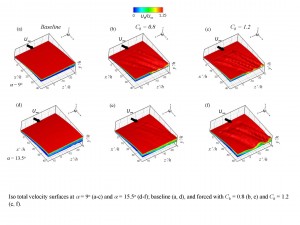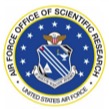The major goal in aerodynamics is to improve vehicle performance over a wide range of operating conditions. This can be achieved by optimizing the shape, or by using either passive or active flow control techniques (e.g., separation suppression at high angles of attack, trim adjustments at low angles of attack or enhanced aerodynamic controllability during transients). Most flow control techniques have been focused on separation control, which has been typically achieved by exploiting the combined narrow-band receptivity of the separating shear layer and the upstream boundary layer to external actuation (Ho & Huerre, 1984). Oster & Wygnanski (1982) and Roberts (1985) showed that external actuation could affect the global flow field by modifying the evolution and interaction of the flow’s large-scale vortical structures. These modifications can lead to a Coanda-like deflection of the separating shear layer towards the surface (Seifert et al., 1996) such that the shear layer amplified disturbances are advected downstream in close proximity to the surface. Ultimately, this phenomenon introduces higher momentum to the separated region and in the time-average sense lead to flow reattachment.

An experimental investigation was performed to study the formation of secondary flow structures due to the interaction of a finite-span synthetic jet with a three-dimensional boundary layer over a finite and swept-back wing configuration (cross-sectional profile of the NACA 4421, aspect ratio of 4 and sweep back angle of 30o). The investigation was carried out at a chord based Reynolds number of 105, two angles of attack of 9o and 15.5o, and two blowing ratios of 0.8 and 1.2. Stereoscopic PIV data were collected around a single synthetic jet actuator in the mid-span of the swept-back wing configuration. The effect of the blowing ratio was analyzed based on the three-dimensional flow field using time-averaged and phase-averaged statistics. Detailed boundary layer profiles show the actuation effects in cases where the jet is introduced to locally attached or separated flow fields, which are determined by the model’s angle of attack. Similar to the interaction of a synthetic jet with a flow over an unswept wing, the flow field in the vicinity of the synthetic jet orifice becomes highly three-dimensional with very distinct secondary flow structures. The flow field is governed by the superposition of two kinds of flow structures: (1) spanwise structures that are generated along the orifice’s span due to the synthetic jet’s vortex pairs, and (2) streamwise structures that are associated with the finite span of the jet (edge vortices). These flow structures are formed almost immediately downstream of the synthetic jet orifice and evolve into a well-organized three-dimensional flow field farther downstream.


